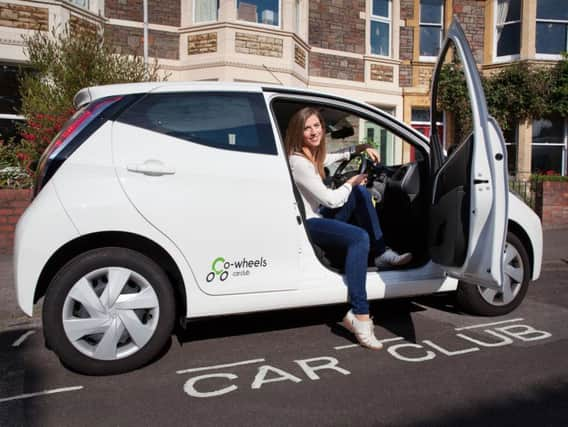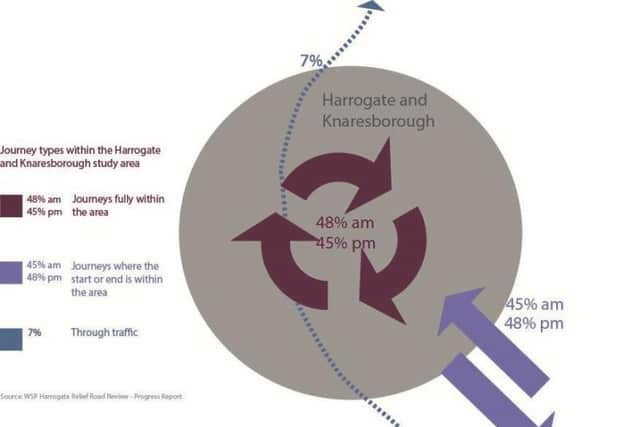The Way Ahead pt 2: 'Green' solutions for Harrogate


Graham Chalmers: What are the travel-related challenges facing Harrogate and Knaresborough?
Jemima Parker, chair, Zero Carbon Harrogate: "Most of us currently have very limited travel choices.
Advertisement
Hide AdAdvertisement
Hide Ad"Buses don’t always go where we want to get to; the rail service is regular but infrequent and only serves some areas of our towns; our pedestrian routes are designed around road users and it’s not perceived as safe to let our children cycle on the roads.


"It is, perhaps, understandable that often we get in the car even to make short journeys. Nearly half of all journeys in Harrogate and Knaresborough are less than 2.6km (1.6 miles) according to a recent North Yorkshire County Council report.
"These short trips, rather than through traffic (which only makes up 7% of vehicle movements), are what has led to the traffic congestion most of us experience every day."Congestion wastes our time and our money (in fuel and businesses’ time), damages our health through poor air quality and lack of daily exercise, reduces the independence of our children, creates additional carbon emissions, and overall diminishes the appeal of our Spa and Heritage towns that drive much of our local economy.
"With significant new housing developments on the horizon now is the time to rethink our transport strategy and look for 21st Century solutions rather than reverting to outdated ineffective methods that prioritise vehicles over people and place. "
Advertisement
Hide AdAdvertisement
Hide AdGC: What change in transport infrastructure would you like to see in the Harrogate area?


JP: "There is no single big project that can fix everything. Some sustainable transport solutions are very simple.
"It’s all about offering attractive alternatives for those journeys that could be done by a different mode of transport, so the roads are less congested for those journeys where the car, van or lorry is the only option. We need investment in a number of solutions that will complement each other.
"Park and ride by bus from the Great Yorkshire Show Ground and the A59/61 Ripon Road, by rail or bus from the A61 south at Pannal and by rail from East Knaresborough with a new rail halt. More than 4.5 million trips were made on Park & Ride services in York in 2016.
Advertisement
Hide AdAdvertisement
Hide Ad"Alex Hornby Chief Executive Officer of Transdev Blazefield has said that the continued congestion and pressure for road space means that buses have to be part of the answer for a sustainable Harrogate both now and in the future.
"Transdev are already introducing a new zero-emission electric fleet during 2018 and the bus station is currently having electric charge points fitted.
"But we also need a network of bus routes that go round town so that you could get directly from, for example, Jennyfields to the Hospital, Starbeck to Cardale Park, Harlow Hill to Hornbeam Park without having to change at the bus station.
"Charging points for electric bikes and cars are important.
"Having a 20mph speed limit throughout our urban areas would make walking more enjoyable and safer for pedestrians.
Advertisement
Hide AdAdvertisement
Hide Ad"Developing “home zones”, where cut through roads are blocked off and effectively turned into cul-de-sacs, where residents reclaim their street space and quiet roads can become pleasant pedestrian and cycle routes with places to play.
"We already have a few streets like this. The St George’s development does not have through traffic, for example.
"Safe segregated cycle routes focused initially around our schools, main centres of employment and for all new housing developments.
"This can be achieved: Cherwell Secondary School in Oxfordshire have worked with their Council to provide alternative transport infrastructure for their students, so now 58% of pupils at cycle to school, 16% travel by bus and 15% walk –a total of 89% who use sustainable means of travel."
Advertisement
Hide AdAdvertisement
Hide AdGC: Give me one example of how you think car travel behaviour can be changed.
JP: "Car clubs are a good example of how the “sharing economy” can help. Zero Carbon Harrogate are working with Harrogate Borough Council to set up a car club.
"Car clubs are already thriving in nearby locations such as Leeds, York and Wakefield.
"Members can book and use the car whenever they want it, for just an hour or the whole day.
Advertisement
Hide AdAdvertisement
Hide Ad"It’s a cheap way to have access to a car, or for a family not to have to pay out for a second car.
"Car club members also choose public transport for more journeys as they consider the options for each journey. "
GC: What about fears that sustainable transport would restrict our local economy?
JP: "On the contrary, foot fall for retail businesses is key. Research by ARUP shows that retailers often overestimate the economic benefits of car based journeys, but that pedestrianization significantly contributes to economic improvements.
Advertisement
Hide AdAdvertisement
Hide Ad"The Victorians were visionary in presenting a spectacular Spa and Heritage brand, Harrogate Spa Water and Betty’s and Taylors sell that for us globally.
"But when people visit and find it’s just like any other urban centre with the design dominated by the car they won’t come back.
"We want a modern urban approach, such as our forebears had, that brings back a world class distinctiveness to our area."
GC: Wouldn’t a relief road be needed as well for Harrogate?
JP: "As Councillor Richard Cooper, Leader of Harrogate District Council put it “it just won’t work, because 93% of those journeys are to or from Harrogate or within Harrogate.”
Advertisement
Hide AdAdvertisement
Hide Ad"Last year North Yorkshire County Council commissioned a report by its consultant transport engineers, WSP, when comparing different sustainable transport and road options for Harrogate and Knaresborough, they concluded that “the poorest performing package was shown to be Package C which comprised only of a relief road intervention.”
GC: Traffic congestion is a real problem for people now, how long would these changes take?
JP: "Some of these sustainable transport options could be very cheaply trialled and then reviewed, for example temporarily running a park and ride form the showground or blocking a residential street.
"So some traffic congestion relief could start now. Others measures could be agreed upon and implemented in just a couple of years.
Advertisement
Hide AdAdvertisement
Hide Ad"In contrast, if NYCC did opt to go ahead with a major new road their report states that it would not be built until at least 2024 and that there is no provision for it in the Harrogate Borough Council local plan which runs till 2035.
The Government’s “Clean Growth Strategy” published last October, shows a shift in the focus of funding towards sustainable transport.
"24% of our national carbon emissions come from transport and to meet legally binding carbon reduction targets this is a key policy area. "The move over to electric vehicles is part of this transition, so we also need be planning for locally generated electricity."
GC: If we could overcome the barriers to change, what would that mean for Harrogate and Knaresborough?
Advertisement
Hide AdAdvertisement
Hide AdJP: "If we were able to invest even a proportion of the estimated £100m cost of a relief road in sustainable transport we would see a transformation for all of us. There would be more choice for everyone about how we travel.
"An increase in public transport, cycling and walking among residents will mean less traffic, easing congestion on the roads and offering a fit for purpose road network that can cope with growth. Less emissions, better air quality, improving the health and fitness of residents."